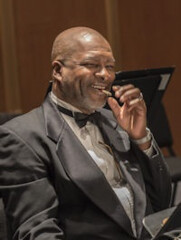by Lara Canner, Allan Blank Curator of Music Special Collections
To celebrate the accomplishments and contributions made by Black composers to classical music, we are focusing on the artists that fill our collections. Today’s focus is on Dr. Harvey J. Stokes: Composer, musician, professor, and author.
As a composer, Dr. Stokes is classified as neoclassical or polyphony (from Greek, meaning “many sounds”). His compositions are layered, lines of different melodies played concurrently creating a musical storytelling affect. To date, Dr. Stokes has written roughly seventy pieces including symphonies, ensemble works, and piano sonatas. Which have played nationally and internationally, most recently at the Virginia Beach Museum of Contemporary Art performed by Symphonicity Orchestra.
Stokes himself notes that composers need to understand how all the pieces of the orchestra work together and sound individually. He is a talented oboist, having played with the Virginia Symphony Orchestra, Norfolk Chamber Consort, the Tidewater Winds, and the Symphonicity Orchestra.
Dr. Stokes has been a faculty member at Hampton University since 1990, he is the founder of their Computer Music Laboratory and has received the Edward L. Hamm Sr. Distinguished Teaching Award in 2017. His lessons and musical influence is felt throughout the Hampton Roads music scene.
Building on his teaching calling, Dr. Stokes has written A Selected Annotated Bibliography on Italian Serial Composers and Compositional Language in the Oratorio the Second Act: The Composer as Analyst. He also a member of the Educational Policy Improvement Center for Hampton University’s Music program and is on the National Council of the Society of Composers. Dr. Stokes former appointments as President of the Southeastern Composers League and consulted for the North Carolina Arts Council.
Interested in learning more about Dr. Harvey J. Stokes? Watch this episode (hyperlink: https://www.youtube.com/watch?v=sbIIr5jkhQE) of WHRO’s Curate 757. His work can be purchased through Ars Nova Music Press, Centaur Records, Albany Records, and Harkie Music.








